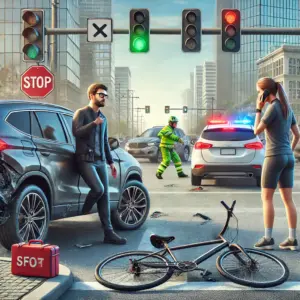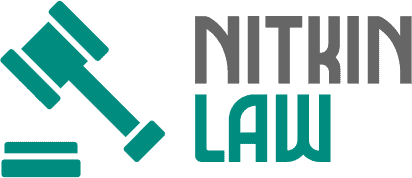
Cycling is a practical, environmentally friendly and healthy mode of transport and recreation, but sharing the road with motor vehicles carries inherent risks. Regardless of your attention and compliance with traffic rules, a collision with a car can happen in an instant, leaving behind injuries, property damage and even long-term consequences for physical and mental health.
If you have been involved in an accident like this, it is crucial to know how to react immediately after the incident in order to protect yourself, your rights and ensure that you are properly compensated.
Safety first
The first priority after a crash is your safety. If you are conscious and able to move without severe pain or visible serious injuries, move off the roadway to a safe place to avoid further hazards, such as other vehicles.
If you feel dizzy, have severe pain, have difficulty breathing or suspect a fracture, do not move. Stay calm and wait for the ambulance to arrive. In such situations, any movement can aggravate the injuries, especially if there is internal bleeding or damage to the spine.
Call 911 immediately, or ask someone nearby to do it for you. Also, contact the police to make an official record of the accident.
Collecting evidence at the scene of the accident
If you are able to think and act after a collision, gathering evidence at the scene can make it much easier to establish the facts and enforce your rights. Write down the license plate number of the car that hit you, and ask the driver for their name, contact information and insurance information.
If possible, obtain information about witnesses. Their statements can confirm your version of events in the event of a dispute.
Use your phone to take photos of the scene – the damage to the bike, the position of the car, the condition of the road, traffic signs, traffic lights and any other elements that may shed light on the cause of the accident.
Medical examinations and documentation of injuries
See a doctor as soon as possible after the accident, even if you have no obvious symptoms. Injuries such as concussions, muscle strains, broken bones, or internal damage may be present but not noticeable for the first few hours or days.
During the examination, be thorough in describing all symptoms, no matter how insignificant they may seem. Ask for copies of all medical reports, X-rays, test results, and bills for medications or therapies.
If the injuries are serious, you may need to consult a specialist (a neurologist, orthopedist, or physiotherapist). Their findings further strengthen your case, especially if long-term therapies or surgeries are required. Keep a record of all expenses and symptoms during recovery, as this information can be included in the final damage assessment.
Relationship with insurance companies
After an accident, expect to be contacted by the driver’s insurance company. While representatives may appear kind and compassionate, their primary goal is to protect the company’s financial interests.
Be careful in communication. Avoid making official statements, signing documents or accepting offers before consulting a lawyer.
It is common practice for insurers to offer a quick settlement in the form of a low amount, with the implication that it is the best you can get. However, such offers rarely reflect the true value of damages, especially when long-term medical expenses or lost earnings are considered.
You should consider getting legal help after a bicycle accident. A lawyer can take over the negotiations, analyze the offer and make sure that you receive compensation for all of your loss.
If the insurance company disputes liability or refuses to cooperate, a legal representative can file a lawsuit. In such cases, court proceedings can take time, but often result in higher compensation if the evidence is on your side.
Legal aid and your rights after an accident
After you’ve taken care of your safety and gathered the basic information, it’s time to think about taking legal action.
You have the right to seek reimbursement for all of these items, but the process can be complex, especially if you face resistance from the insurance company or a dispute over liability.
Hiring a lawyer who specializes in bicycle accidents and injuries can make all the difference. An experienced legal professional can analyze your case, collect additional evidence (e.g. camera footage, road condition expertise), and negotiate with insurance companies who often try to reduce the payout or shift the blame to the cyclist.
For example, a common insurance tactic is to claim that you were not wearing a helmet or that you violated a traffic law, even if this did not directly contribute to the accident. A lawyer will know how to challenge such arguments and protect your interests.
Recovery and return to driving
Physical recovery depends on the severity of the injuries. Minor injuries can heal in a few weeks, while more serious problems can require months of rehabilitation, including physical therapy or even surgery. Fear of re-crashing or traffic anxiety is common after an accident and can affect your willingness to get back on the bike.
When you’re ready to drive again, consider additional safety measures. Wear a high-quality helmet, use reflective clothing, install strong front and rear lights on your bike, and choose routes with less traffic or bike lanes.
Prevention of future accidents
Regularly check the condition of the bike – brakes, tires and lighting – to ensure it is in working order. Respect the traffic rules, signal your intentions with your hands and avoid driving in the blind spots of the vehicle.
In some cases, accidents reveal systemic problems, such as poor infrastructure or inadequate traffic signs. If you believe the accident was partly caused by these factors, consider reporting it to the local authorities. Your initiative can contribute to improving safety for other cyclists.
Conclusion
What steps will you take today to safeguard your rights and recovery after a bicycle accident? The aftermath of a collision can be overwhelming, but taking immediate action (securing evidence, seeking medical attention, and consulting a legal expert) can significantly impact your ability to receive fair compensation. Insurance companies often prioritize minimizing payouts, making legal guidance essential to counter their tactics and protect your interests.
While physical recovery may take time, financial stability and legal clarity can help you move forward with confidence. By knowing your rights and advocating for safer cycling conditions, you not only protect yourself but also contribute to a more secure road environment for all.

